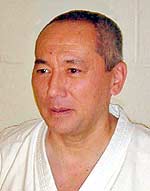Martial Mania
Uso Kumite / Yakusoko Kumite
By George Donahue

Much of what we practice in our martial traditions is the art of deception.
It’s a paradox we tend to ignore for a while but which we eventually
have to deal with. While we strive to develop greater honesty and honor
in ourselves and our students, if we have a true concern for their safety
and well-being, as well as our own, we must also teach them how to act
in such a way that an attacker cannot anticipate their reactions to an
attack. That is, we must teach them, at first, not to telegraph their
intent, and later how to make the attacker think the erstwhile victim
is going to do something that the victim is not, and to not realize, until
too late, that the victim has done or is doing something else entirely.
That is strategy, of course, but at its core it’s the Machiavellian
art of deception and psychological manipulation—Sun Tzu rather than
Mr. Rogers.
Unfortunately, a lot of our training is counterproductive for this end.
For example, just about all schools of all martial traditions practice
some variety of yakusoku “promise” kumite, whether they call
it that or not. This is prearranged sparring or drill in which the defender
knows beforehand exactly what the attacking partner will do. The attacker
promises to attack only in a certain way and the defender is responsible
for defending against that exact attack and no other. When yakusoku kumite
is done well, it’s a very useful tool for beginners, especially
if the repertoire includes a wide variety of attacks. It’s also
good for choreographed demonstrations of an art for consumption of the
general public. It is almost never a good tool for intermediate or advanced
students. When students practice yakusoku kumite for too long, their movements
become robotic and their timing becomes too plodding, even at full speed.
Even worse, their thinking becomes robotic, predictable, and inferior.
If they rely too much on this sort of training, they don’t stand
much chance against even an ordinary street thug. What starts as a reasonable
training regimen becomes ridiculous, not just useless, but actually harmful.
On the other hand, most schools don’t practice enough uso kumite.
Many don’t practice it at all. That is a great shame.
Uso means “lie” or “deception” or “untrue.”
So uso kumite is practice in lying, either verbally or physically. The
principles of uso kumite are built into kata. The kata Chintô, for
example, has elements of deception in almost half the moves. When Chintô
or any other kata is practiced without taking into account its chicanery,
then it’s in danger of being merely a graceful exercise and not
a rich repository of fighting applications.
There are many ways to practice uso kumite and many concrete exercises
to develop skills in deception. I’m not going to discuss specific
exercises here, but perhaps I’ll write about them in the Martial
Craftsman (regular articles by this author) series on FightingArts.com,
if there is any interest. If you agree that deception is a useful skill,
then you can easily develop your own exercises. Thinking up deception
exercises can actually help you become capable of more deception, whether
you practice the exercises or not.
In sum, when someone is trying to kill you, or otherwise harm you or your
companions, you have no obligation to play fair.
About The Author:
George Donahue has been on the board of FightingArts.com
since its inception. He is a freelance writer and editor, providing literary
and consulting services to writers, literary agents, and publishers, as
well to advertising agencies. He has worked in publishing for more than
three decades, beginning as a journal and legal editor. Among his positions
have been editorial stints at Random House; Tuttle Publishing, where he
was the executive editor, martial arts editor, and Asian Studies editor;
and Lyons Press, where he was the senior acquisitions editor and where
he established a martial arts publishing program. He is a 6th dan student
of karate and kobujutsu—as well as Yamane Ryu Bojutsu—of Shinzato
Katsuhiko in Okinawa Karatedo Shorin Ryu Kishaba Juku. He was also a student
of Kishaba Chokei and Nakamura Seigi until their deaths. He teaches Kishaba
Juku in New York and Connecticut, as well as traveling to provide seminars
and special training in karate, weapons, and self-defense. His early training
was in judo and jujutsu, primarily with Ando Shunnosuke in Tokyo. He also
studied kyujutsu (archery), sojutsu (spear), and kenjutsu (swordsmanship)
in Japan as a youth. Following his move to the US, he continued to practice
judo and jujutsu, as well as marksmanship with bow and gun, and began
the study of Matsubayashi Ryu karate in his late teens. Subsequently,
he has studied aikido and taiji and cross trained in ying jow pai kung
fu. |